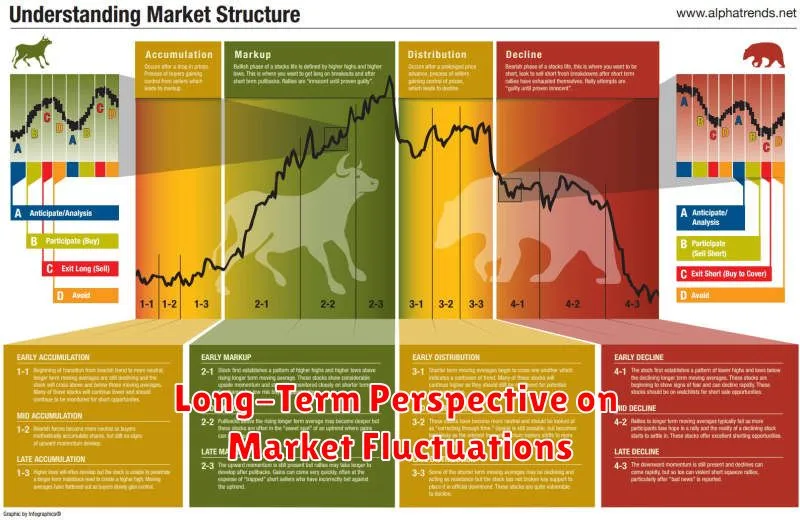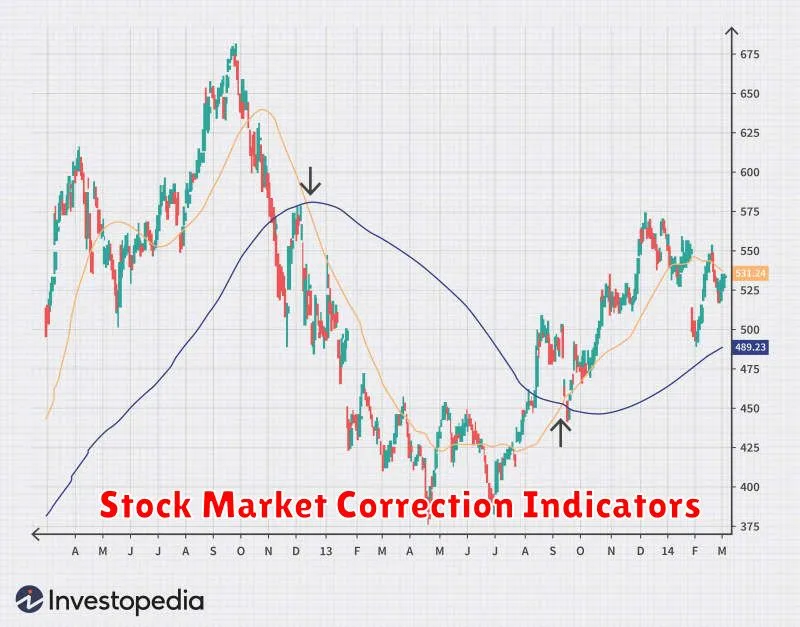The stock market is a dynamic and unpredictable environment, subject to fluctuations that can affect investors’ portfolios. While growth is often the goal, it’s crucial to acknowledge the possibility of corrections, which are significant declines in market prices. Recognizing the warning signs of a market correction is paramount for any investor, as it allows you to take proactive steps to protect your investments. This article will guide you through key indicators and strategies to navigate these challenging periods.
Understanding the causes behind market corrections is essential for effective risk management. From economic downturns and geopolitical tensions to rising interest rates and inflation, numerous factors can trigger a downward trend. Identifying these corrective signals early on empowers you to make informed decisions about your investment portfolio, potentially minimizing losses and navigating the market with greater confidence.
Defining Stock Market Corrections
A stock market correction is a decline of 10% or more in a major market index, such as the S&P 500 or the Dow Jones Industrial Average. It’s a natural part of the market cycle, and while it can be unsettling for investors, it’s not necessarily a cause for panic. Corrections are typically short-term, lasting a few weeks or months, and are often followed by a rebound in prices.
It’s important to distinguish between corrections and bear markets. A bear market is a more significant decline of 20% or more, and typically lasts for a longer period, often several months or even years. While both corrections and bear markets are periods of decline, corrections are generally considered less severe and less lasting.
Corrections are driven by a variety of factors, including:
- Economic concerns
- Geopolitical events
- Inflation
- Interest rate hikes
- Overvaluation of stocks
While corrections can be unsettling, it’s crucial to remember that they are a normal part of the market cycle. Long-term investors should not panic during corrections, but instead, consider it an opportunity to rebalance their portfolios and potentially buy stocks at discounted prices.
Distinguishing Between Corrections and Bear Markets
Navigating the stock market requires understanding its inherent volatility. Two terms frequently used in discussions about market fluctuations are “corrections” and “bear markets“. While both represent downward movements in stock prices, they differ significantly in their magnitude and duration. Distinguishing between the two is crucial for investors to make informed decisions and protect their portfolios.
A correction is a decline of 10% or more in a major market index, such as the S&P 500. Corrections are typically short-lived, lasting a few weeks or months, and are often characterized by sharp declines followed by a quick rebound. They are considered a normal part of the market cycle and are often driven by factors such as economic uncertainty, geopolitical events, or investor sentiment.
On the other hand, a bear market is a more prolonged and severe downturn, typically defined as a 20% or greater decline in a major market index. Bear markets can last for several months or even years and are characterized by sustained selling pressure and widespread pessimism. They often occur during periods of economic recession or financial crisis and can have a significant impact on the economy and individual investors.
Here’s a table summarizing the key differences between corrections and bear markets:
| Feature | Correction | Bear Market |
|---|---|---|
| Magnitude | 10% or more decline | 20% or more decline |
| Duration | Few weeks to months | Several months to years |
| Sentiment | Short-term fear and uncertainty | Sustained pessimism and panic |
| Economic Impact | Minor impact | Significant impact on the economy |
Understanding the distinction between corrections and bear markets allows investors to adopt appropriate strategies. During corrections, investors may choose to hold their positions, as these downturns are typically temporary. However, during bear markets, a more cautious approach may be necessary, such as reducing risk exposure or seeking alternative investment opportunities.
Economic Indicators to Monitor
While it’s impossible to predict the stock market with certainty, understanding and monitoring key economic indicators can provide valuable insights into potential market shifts and help investors identify early warning signs of a correction.
Inflation is a crucial indicator as rising prices can erode corporate profits and consumer spending, leading to stock market volatility. The Consumer Price Index (CPI) and Producer Price Index (PPI) are commonly tracked measures of inflation.
Interest rates play a significant role in market performance. The Federal Reserve’s (Fed) interest rate decisions directly impact borrowing costs for businesses and consumers, influencing economic growth and stock valuations. The Fed funds rate and the yield on the 10-year Treasury note are key interest rate indicators.
Employment data offers insights into the health of the economy. The unemployment rate and nonfarm payrolls reveal the strength of the labor market, which can impact corporate earnings and investor confidence.
Gross Domestic Product (GDP) is a comprehensive measure of economic activity. Tracking GDP growth provides an overall picture of the economy’s performance and its potential impact on stock market direction.
Consumer confidence reflects consumer sentiment and spending patterns, which are crucial drivers of economic growth. The University of Michigan Consumer Sentiment Index and the Conference Board Consumer Confidence Index are prominent measures of consumer confidence.
By closely monitoring these economic indicators, investors can gain a better understanding of the underlying health of the economy and make informed decisions to navigate potential market corrections.
Market Sentiment and Investor Behavior
Market sentiment, the prevailing mood or attitude of investors towards the stock market, plays a crucial role in shaping market trends. When investors are optimistic and confident, they tend to buy stocks, driving prices higher. Conversely, when pessimism prevails, investors sell their holdings, leading to a decline in prices.
Investor behavior, driven by emotions and psychological biases, can amplify market sentiment. During periods of market euphoria, investors often exhibit herd behavior, chasing after popular stocks and ignoring potential risks. This can create bubbles, where asset prices rise to unsustainable levels.
Conversely, during periods of market fear, investors tend to panic sell, exacerbating market downturns. This can lead to a vicious cycle of selling, further depressing prices and intensifying market volatility.
Understanding market sentiment and investor behavior is essential for investors seeking to protect their investments. By recognizing signs of excessive optimism or pessimism, investors can adjust their portfolio strategies and avoid being caught in market bubbles or crashes.
Technical Analysis Signals of a Correction
Technical analysis is a powerful tool for identifying trends and potential reversals in the stock market. While it’s not a foolproof method, certain technical indicators can signal an impending correction. Recognizing these warning signs allows investors to adjust their portfolios and protect their investments.
One of the most prominent signals is the Relative Strength Index (RSI). When the RSI surpasses 70, it suggests an overbought market, indicating a potential pullback. Conversely, a reading below 30 indicates an oversold market, signaling a possible rebound.
Another crucial indicator is the Moving Average Convergence Divergence (MACD). A bearish crossover, where the MACD line crosses below the signal line, can be a warning sign of a downward trend. Similarly, a bullish crossover suggests a potential uptrend.
Price action patterns are also valuable for recognizing corrections. Head and shoulders patterns, double tops, and triple tops are bearish formations that suggest an impending price reversal.
Volume plays a significant role in confirming technical signals. High volume during a price decline can indicate a strong selling pressure, increasing the probability of a correction.
It’s important to note that technical signals alone shouldn’t be the sole basis for investment decisions. Always consider fundamental factors, economic indicators, and overall market sentiment when assessing potential corrections.
[object Object]
Investment Strategies During a Correction
A stock market correction is a decline of 10% or more from a recent peak. Corrections can happen quickly and unexpectedly, and they can be unsettling for investors. However, it’s important to remember that corrections are a normal part of the market cycle. They are typically followed by periods of growth, and they can offer opportunities to buy stocks at discounted prices.
If you’re worried about a stock market correction, there are a few things you can do to protect your investments.
1. Rebalance Your Portfolio
A good way to protect your investments during a correction is to make sure your portfolio is properly balanced. This means having the right mix of stocks, bonds, and other assets. If your portfolio is heavily weighted towards stocks, you may want to consider selling some of your stocks and buying more bonds. This will help to reduce your risk during a correction.
2. Review Your Risk Tolerance
It’s also important to review your risk tolerance during a correction. This is how much risk you’re comfortable taking with your investments. If you’re feeling anxious about the market, you may want to consider moving some of your investments to less risky assets, such as bonds or cash. However, you should have a long-term strategy and not panic sell.
3. Consider Dollar-Cost Averaging
Dollar-cost averaging is a strategy that involves investing a fixed amount of money at regular intervals. This helps to reduce the impact of market volatility because you’re buying stocks at different prices over time. This strategy can help you buy stocks at lower prices during a correction.
4. Stay Disciplined
It’s important to stay disciplined during a correction. This means sticking to your investment plan and avoiding emotional decisions. Don’t try to time the market or sell your stocks just because the market is down. Remember that corrections are temporary and the market will eventually rebound.
Corrections are a normal part of the market cycle. By following these strategies, you can help protect your investments during a correction and position yourself for long-term success.
Protecting Your Portfolio from Downside Risk

Market corrections are a normal part of the investment cycle. They are characterized by a sudden and significant drop in stock prices, typically 10% or more. While they can be unsettling, understanding the warning signs and taking steps to protect your portfolio can help you navigate these periods successfully.
One of the most effective strategies is to diversify your portfolio across different asset classes, such as stocks, bonds, real estate, and commodities. This helps to reduce the overall risk of your investments by spreading them across various market sectors. If one sector experiences a downturn, the others may provide a buffer.
Another essential step is to manage your risk tolerance. Before making any investment decisions, it’s crucial to understand your own comfort level with potential losses. If you are particularly risk-averse, consider investing in more conservative assets, such as bonds or cash.
Consider adopting a dollar-cost averaging strategy. This involves investing a fixed amount of money at regular intervals, regardless of market fluctuations. By doing so, you’ll buy more shares when prices are low and fewer when they are high, averaging out your purchase cost over time.
Finally, it’s important to stay informed about market trends and economic indicators. Keep an eye on leading economic indicators, such as consumer confidence, manufacturing activity, and interest rate changes, as they can provide insights into the health of the economy and potential market shifts.
Remember, market corrections are a part of investing. By taking proactive steps to manage your risk and diversify your portfolio, you can navigate these periods with greater confidence and potentially emerge with stronger returns in the long run.
Opportunities for Value Investors

While market corrections can be unsettling for many investors, they present a unique opportunity for value investors. These corrections often lead to a temporary decline in stock prices, creating a window to buy undervalued companies at discounted prices. Value investors thrive in these environments by focusing on the intrinsic worth of a company, rather than short-term market fluctuations.
During a correction, investors with a long-term perspective can identify companies with solid fundamentals but temporarily depressed valuations. This presents an opportunity to acquire shares at a bargain, potentially unlocking significant returns as the market recovers. By utilizing their fundamental analysis skills, value investors can pinpoint companies with strong earnings potential, robust balance sheets, and a sustainable competitive advantage, even amidst market turmoil.
Remember, market corrections are a natural part of the investment cycle. Instead of panicking, view them as a chance to refine your investment strategy and take advantage of potentially lucrative opportunities. By remaining disciplined and focusing on the long-term, value investors can navigate market corrections effectively and potentially capitalize on the subsequent rebound.
Long-Term Perspective on Market Fluctuations

In the realm of investing, it’s crucial to maintain a long-term perspective, particularly when navigating market fluctuations. While short-term volatility might trigger panic, it’s essential to remember that the stock market historically has always rebounded from corrections and bear markets. Focusing on the long-term growth potential of your investments allows you to ride out temporary downturns and reap the rewards of compounding over time.
Market corrections, which are declines of 10% or more in the major stock indices, are a natural part of the market cycle. They can be triggered by various factors, including economic concerns, geopolitical events, or investor sentiment. While these corrections can be unsettling, they often present opportunities for investors with a long-term horizon to buy quality stocks at attractive valuations.
A long-term investment strategy is essential for weathering market storms. By staying invested and avoiding emotional decision-making, you allow your portfolio to benefit from the inherent growth potential of the stock market. Instead of succumbing to fear and selling during downturns, consider using these periods to rebalance your portfolio and explore new investment opportunities.
Remember, the stock market is a marathon, not a sprint. By maintaining a long-term focus, you can navigate market fluctuations with confidence and ultimately achieve your financial goals.

